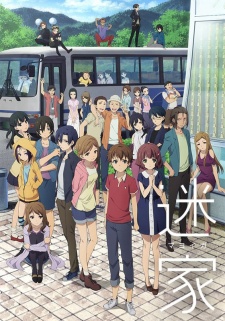
We begin in a bus. Thirty people are on a tour into the woods and off the map, looking for a place to start over and escape the traumas they induced living their day-to-day lives in the real world. The place they are searching for is Nanaki Village, a mysterious little village nestled in the mountains far from any human interference. Luckily one of the tour guides has a map to lead them there, although frankly the roads all the way over are pretty clearly marked and mostly paved, so all things considered it’s a wonder there weren’t more people who had already found it. After coming on the tour with self-assigned monikers to represent their new lives, they all finally reach the village, only to find it deserted despite countless traces of human life there previously.
It’s here that The Lost Village stands at a bit of a crossroads. It could go the full slice of life route, exploring their new lives in this country village while dealing with their scars from the past, but with the darker palate set in the first episode and them getting to the village two episodes in this one seems unlikely. There’s another option, the exact opposite route, where it devolves into bloody murder, whether supernatural or on account of one another, something between Another and Lord of the Flies. Unfortunately this one is out too; for all the big game that it talks, by the end there'll be far too many characters left alive for it to be that sort of horror.
What’s left for The Lost Village is to shoot for the same sort of psychological action but completely miss the mark. There’s already a pervading sense of distrust and anxiety between them all, but as one of the tour group members goes missing all hell breaks loose in a firestorm of accusations and factions splitting off. And for the entire show, this is all that they do: accuse each other and split off into groups. Once or twice there’s a movement for one group to actually act on their baseless accusations and take up arms against the others, but these scenes last for a few minutes at best before the status quo of peaceful angry yelling is restored. I just wanted someone to pull out a knife and hurry the damn discussion up.
About halfway through, a new plotline emerges that moves to the forefront of the story as monsters appear from the woods, each visible to only one member of the tour and taking the shape of something from their past. This prompts them each to take their respective turn reminiscing on their life, their trauma, and their ultimate reason for joining the tour. Some are fairly stale albeit realistic, such as the usual domestic abuse plotline, while some are truly interesting, with one boy being forced to take his dead brother’s name to appease his demented mother for years, and another who relied on his best friend to always do what he said so that he could enact a power fantasy on them as a way of dealing with his controlling mother. These are generally the stronger parts of the show, as a bus full of thirty traumatized escapees can certainly hold a quite a few emotionally charged stories to tell.
How they proceed from there on out is a little less comprehensible. The mechanics of entering and exiting Nanaki Village are tied to people dealing with their traumas, as if this were a way to both explain the monsters and explain why normal people don’t just end up there despite there being a paved road leading all the way up to the entrance. When the monsters start becoming the focus, it does feel like the village itself becomes fairly irrelevant, as if it were just a stand-in for any place away from the public eye, and the matters they had considered earlier on such as logistics and standard of living fall to the backdrop. We meet a man who escaped the village once before, and the cost of him having not dealt with his monster “the fair way” seems arbitrary, contrived, and completely nonsensical.
It turns out that his reason for being in the show is to give a motive to the central villain, who is revealed at the last second just as it seemed like there was no actual machinations going on besides people’s paranoia and dealing with the monsters of their past. At that point introducing such a figure seems like nothing more than a ploy, to give a central conflict outside of people working past their traumas and accepting reality. The conflict comes to a head in the last episode, which is rushed beyond all belief and refuses to give us any time to process neither the characters’ emotional breakthroughs nor their ultimate decisions on how to best continue on living once the series ends. And the way that they deal with their traumas—or that the antagonist preys upon them—are so straightforward, so characteristic of the anime mentality that mental illness is fully beaten by accepting yourself in a glorious flash of light after one or two people you care about say that you matter. If The Lost Village was serious about taking on the hefty question of trauma it set itself up for in its breakneck sprint to the end of the series, they probably should have spent a little less time pointing fingers and yelling.